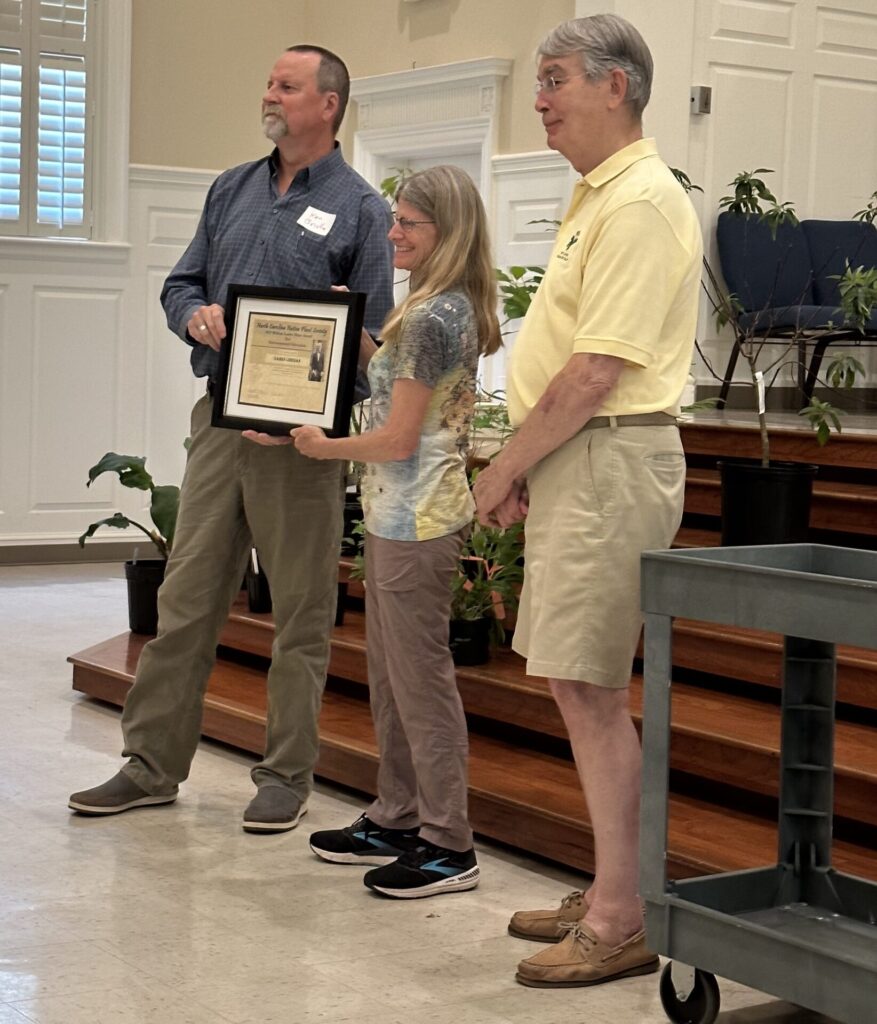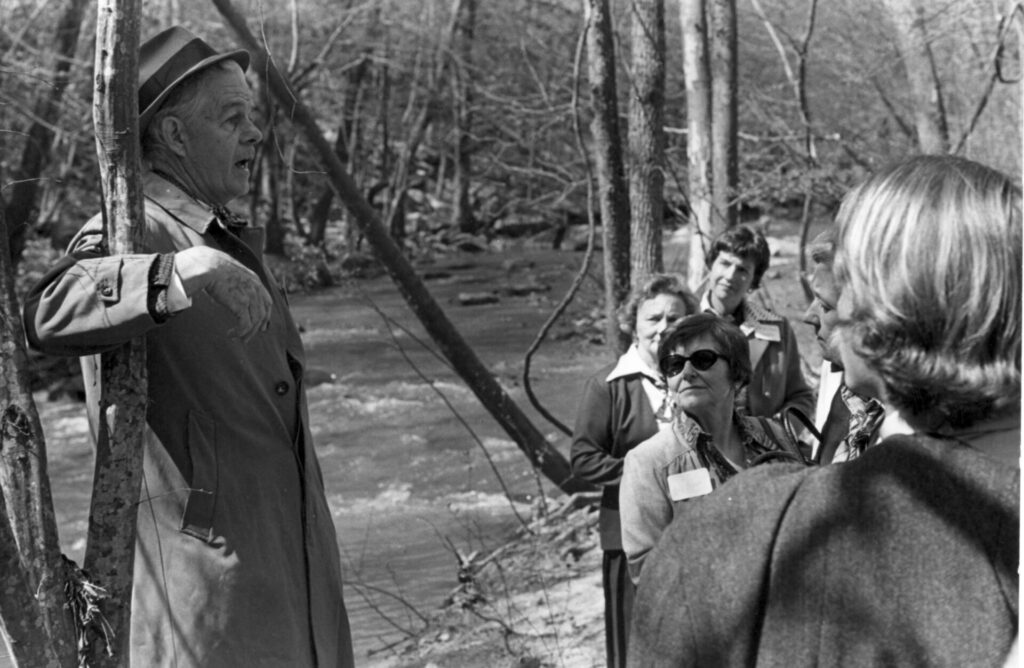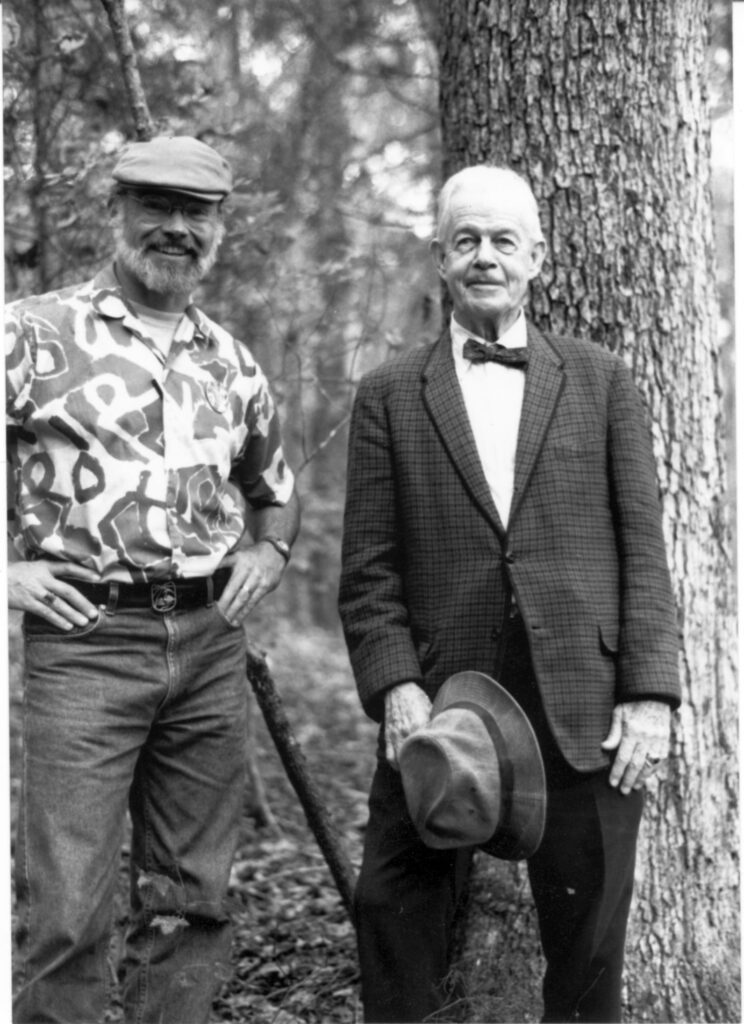By Margot Ringenburg
Who was William Lanier Hunt and why is our award for environmental education named in his honor? Who received the William Lanier Hunt Award award this year? In answer to the second question, it was given to Karen Linehan, a lifelong educator at the Friends School of Wilmington. This distinct honor, the William Lanier Hunt Award for Environmental Education, was announced during the NC Native Plant Society annual meeting. To read a more complete story of Karen Linehan and the Friends School of Wilmington, read Karen’s story by Shelagh Clancy in the fall 2022 Native Plant News, “Teaching Toward a Native Future.”

The answer to the first question is a bit more involved. Older NC Native Plant Society members may be familiar with the name William Lanier Hunt, a true Southern gentleman and horticulturist for whom our Environmental Education Award is named. He is a man to be remembered and admired for his contributions to land conservation and the preservation of our state’s native plants.
William Lanier Hunt, the youngest son of Webster and Cammie Cook Hunt, was born on May 22, 1906, in Pomona, NC, which at that time was a small town to the southwest of the center of Greensboro. For much of his life, he was known by close friends and family as ‘Billy’ and by others as ‘Bill.’ Southern garden writer Elizabeth Lawrence confessed that, as Hunt grew older, she “tried to remember not to call William Lanier Hunt ‘Billy,’ but [she] usually forgot.”
The South’s largest nursery was right next door
As a child, Hunt lived next door to Lindley Nurseries, the oldest and largest nursery in the South at that time. It had been founded in 1822, covered 400 acres, held fourteen greenhouses, and included European gardeners among its staff. The nursery was owned by William Hunt’s uncle, John Van Lindley, his mother’s brother.
According to Ken Moore, former assistant director of the North Carolina Botanical Garden, when Hunt’s parents sent him to Woodberry Forest, a preparatory school in Virginia, Hunt was already writing horticultural articles for newspapers and magazines.
In 1927, Hunt continued his education at the University of North Carolina at Chapel Hill, taking with him truckloads of plants and pursuing a degree in botany under Dr. William Chambers Coker. Elizabeth Lawrence’s sister Ann, who attended UNC at that time, was once told, “There is a boy here you would like; he brought his garden with him when he came to Chapel Hill.”

It was during his years as a UNC student that Hunt first set eyes on the bluffs covered with Catawba Rhododendron (Rhododendron catawbiense) that lined a stretch of Morgan Creek to the south of town. In 1937, Hunt used a portion of his inheritance to purchase 304 acres of land along Morgan Creek for the sum of $3,250. The Copperline Chronicles, a book published in 2020 by the Chapel Hill Historical Society, makes clear that this was not necessarily done for the purpose of conservation alone: “Hunt engaged in small-scale mining, quarrying decorative flagstone and slate for use in whetstones.” Furthermore, in the 1950s and ‘60s, a portion of this land was subdivided, developed into housing lots, and sold by Hunt and Coker.
Hunt honors Morgan Creek; so do others
Singer and songwriter James Taylor grew up in the neighborhood and spent his childhood playing on the banks of Morgan Creek. He looks back on this simpler time in a song titled “Copperline.” When asked about the song during an interview in 2015, Taylor said, “This is about . . . a childhood that was peaceful . . . . I felt like I was part of a landscape in those days – the trees, the streams and the rivers, the animals that lived there.” The song title alone sprang, in part, from Taylor’s memories of the copper-colored leaves of the beech trees that brightened the slopes above Morgan Creek in late fall and winter.
He dubbed his donated acreage ‘Little Asheville’
In 1961, Hunt donated 103 acres, including the rhododendron bluffs that he loved, to the University of North Carolina for the purpose of establishing the North Carolina Botanical Garden. The Garden officially opened to the public in 1966. Prior to its opening, Hunt designed the first of its Nature Trails. The trail crossed Meeting-of-the-Waters Creek, then led straight up the hill, in a beeline, to the top of a ridge overlooking the Morgan Creek watershed. An experienced trailblazer would likely have designed the trail so that it followed the contours of the land, thereby minimizing issues of erosion, but, according to Ken Moore, Hunt’s goal was for hikers to feel as though they were in the mountains; Hunt even referred to the area as ‘Little Asheville.’
In 1967, in order to circumvent the Garden’s total reliance on the University or State for operating funds, Hunt established the Botanical Garden Foundation, a non-profit organization whose purpose was to provide financial support to the Garden. Its initial mission was “Conservation through Cultivation” — later changed to “Conservation through Propagation.” Hunt was elected as the Foundation’s first president.
Hunt was a gad-about-town; he knew and talked to everyone. He served as a mentor to some, one of them being Ken Moore, who became the Garden’s first employee and, later, its superintendent. Ken once reminisced, “I realized, at the late age of 21, that I really wanted to spend my time outdoors, and Bill said, ‘You can.’ It was he who introduced me to the possibility of outdoor work in the fields of Horticulture and Botany.”
Despite his generous inheritance and personal connections, Hunt lived modestly, residing during his later years in an apartment attached to a house along Laurel Hill Road, overlooking the Morgan Creek Valley and its rhododendron bluffs, and within walking distance of the Garden he helped to establish. William Lanier Hunt died on October 19, 1996.
By Margot Ringenburg
Native Plant News – Fall 2023

Margot Ringenburg is vice president of the North Carolina Native Plant Society, legacy member of The Nature Conservancy, a member of New Hope Audubon, and a Garden Guide at the North Carolina Botanical Garden.

